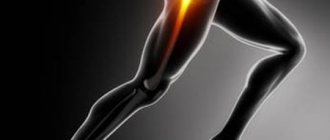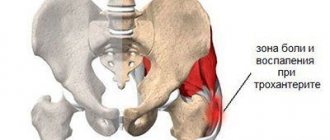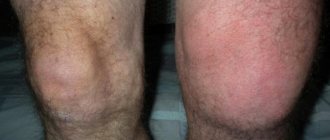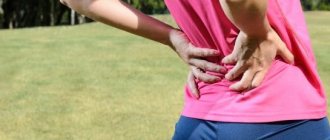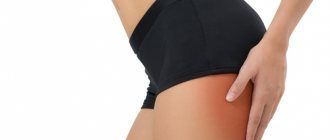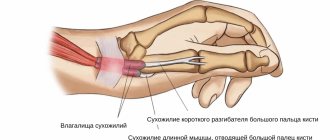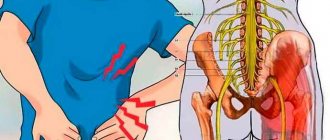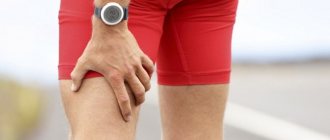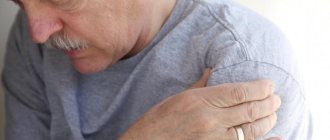The hip joint is one of the largest joints in the human skeletal system. Pathologies and diseases of the hip joint lead to disruption of many functions and greatly impair the quality of life. A pinched nerve in the hip joint is its compression by muscle or ligament cords, neoplasms, displaced and damaged tissues due to one reason or another. This pathology manifests itself as acute pain in the hips, buttocks and lower back.
Why pinching occurs
The main reasons are the following:
- Osteochondrosis of the lumbar spine is a degenerative process that causes destruction of cartilage and bone tissue, with protrusion of discs and hernias that compress the nerve roots in the place where they exit the spinal cord canal.
- Inflammation of the piriformis muscle, which happens under heavy load - long walking or running, jumping, in people unaccustomed to sports, as well as when they are in an uncomfortable position for a long time and during hypothermia - spasm of the piriformis muscle pinches the sciatic nerve.
- The nerve is also infringed by tumor formations.
The formation of sciatic nerve pinching in the hip joint is influenced by a number of provoking factors:
- excess weight and sedentary lifestyle;
- joint diseases and bone pathologies;
- injuries and inflammation of the hip joint and organs in this area;
- severe colds;
- hereditary predisposition, which largely determines the anatomical features of the location of the neurovascular bundles and ligamentous apparatus, as well as congenital defects of the articular apparatus, for example, hip dysplasia.
Separately, it is worth noting such a cause of pinching of the sciatic nerve in the hip joint as pregnancy. An increase in the load on a woman’s body, caused by an enlarging uterus, putting pressure on many organs and nerve bundles, careless movement can provoke pinching. Pregnancy also increases the load on the spine, which can also cause lower back pain caused by a pinched nerve. This can also occur with postpartum divergence of the pelvic bones.
Relapse Prevention
How to avoid re-incarceration of the nerve of the hip joint? The following preventive measures will help:
- Sleep on an orthopedic mattress and pillow.
- Therapeutic exercises and regular warm-ups.
- Arranging a comfortable workplace.
- Treatment of diseases that can cause nerve compression (osteochondrosis).
Try not to sit in drafts, avoid stress, hypothermia and injury.
Click on photo to enlarge
Clinical picture
Among the symptoms of pinching of the sciatic nerve in the hip joint, the main one is sharp, acute pain in the lumbar region radiating to the thigh and buttock. The intensity of the pain makes it impossible to move, bend, walk, or perform other leg movements.
In addition to pain, patients also indicate the following list of symptoms:
- Limitation of the range of motion of the hip joint.
- Paresthesia is a feeling of tingling and burning at the site of the lesion.
- Numbness at the site of injury.
- In some cases, fever, chills, sweating, and weakness occur.
The transmission of pain to the leg or back is called sciatica and is quite common in patients with pinched sciatic nerves, especially when trying to change position - stand up or lie down, or during physical activity.
Forecast
The prognosis for the disease depends on the cause of nerve compression. If it is easy to eliminate, improvement occurs in 1–2 weeks. 90% of patients recover completely.
If the cause of the pathology is osteochondrosis, the length of stay in the hospital can be 40–45 days. This pathology cannot be cured; it regularly recurs (the nerve is pinched again and again).
In the case of prolonged or repeated compression, it takes 4 to 12 months (or more) to restore nerve function. In 80% of patients, sensitivity disorders of varying degrees remain - up to complete immobility of the limb and disability of the patient.
How is diagnostics carried out?
Typical patient complaints of pain and its return, paresthesia and associated symptoms usually facilitate the diagnosis of a pinched nerve in the hip area. The doctor collects anamnesis and prescribes visual and laboratory diagnostic methods to confirm the diagnosis and select subsequent treatment:
- CT, MRI of the spine and soft tissues;
- radiography of the pelvic bones and spine;
- Ultrasound of the hip joint;
- electromyography;
- general and biochemical blood tests, general urine analysis.
Pinching treatment
It is necessary to treat this pathology: in an advanced state, the symptoms worsen and spread over a large area of the affected area. A neurologist or therapist should treat a pinched nerve in the hip joint.
Treatment in some cases is conservative and includes a set of methods:
- a course of painkillers, with the prescription of a course of analgesics. Among them are Analgin, Novocain, Ketorol and others. These drugs are administered intramuscularly at the beginning of treatment, then the patient is transferred to oral administration;
- non-steroidal anti-inflammatory drugs – drugs that relieve inflammation, pain and swelling. These include Diclofenac, Indomethacin, Nimesulide, Ketoprofen, Movalis and others. They are prescribed by injection during the first days of therapy, after which they are taken orally in tablet form. The same drugs can be used topically, in the form of ointments and creams applied to the hip area;
- physiotherapeutic procedures. These include hardware treatment methods: electro- and phonophoresis, magnetic therapy, UHF, laser, diadynamic currents, also hot baths, wraps, paraffin applications, splinting and massage. Massage in the category of physiotherapeutic procedures is quite popular among prescriptions, as it is highly effective in relieving pinched nerves, and the combination of massage actions with locally acting agents containing bee products and snake venom speeds up recovery. At the same time, massage and all types of manual therapy require the supervision of a doctor in order to avoid complications and are carried out when acute phenomena subside;
- physiotherapy. It begins with a set of exercises lying down while the patient is in bed - flexion-extension of the legs at the hip and knee joint, abduction-adduction of the leg in the joint, rotation of the leg. As the patient recovers, he can perform exercises while standing, strengthening the muscular frame of the back. These include squats and bends. All exercises for the hip joint should be carried out under the supervision of an instructor, at least for the first time;
- hormonal drugs. If there is no effect from other medications and physical therapy, the doctor may prescribe a course of drugs containing hormones;
- methods of oriental medicine. In the treatment of neurological diseases, alternative treatment approaches show high effectiveness and can be prescribed along with other methods. These include acupuncture, stone therapy, hirudotherapy and manual therapy techniques. The principle of their work is to influence the active areas of the body, which stimulates blood circulation in the affected area, eliminates congestion, relieves pain and inflammatory processes;
- folk remedies. At home, pinching in the hip joint is treated with baths with decoctions of medicinal plants - thyme leaves, calamus roots, oak bark. You can also take infusions of oregano, horse chestnut and chamomile. It is also recommended that home remedies include a mixture of ground walnuts, sunflower seeds, dried apricots and prunes - these products have a beneficial effect on the joint system. However, treatment of pinching at home should be complementary to the main course of medical prescriptions, and not independent;
- daily routine and diet. Patients with acute pain must observe strict bed rest during the first days of the disease; after 2-3 days they are allowed to get out of bed, move within the room, and after a week - go outside. The bed is recommended to be flat and hard to avoid displacement of the vertebrae. The sleeping position should be on your side or back, with a small pillow placed under your shin. The pillow under your head should be low.
The diet of such patients involves the exclusion of salty, spicy, smoked foods. The diet should include vegetables, fruits, stewed and boiled meat, water-based porridge, and low-fat soups.
If the process is advanced, surgical treatment may be indicated, when an operation is performed to remove tissue pressing on the sciatic nerve.
Treatment of a pinched nerve during pregnancy occurs with the same symptoms, but treatment is prescribed taking into account the woman’s condition and excludes drugs with a negative effect on the fetus. Local anti-inflammatory drugs are used, for example, Voltaren, Menovazin ointments, compresses on the lumbar region, gentle massage and light gymnastic exercises.
During pregnancy, surgical interventions are usually not performed, since this condition is most often temporary. It can be alleviated with mild conservative therapy, and it goes away after childbirth.
To exclude recurrences of a pinched nerve, it is necessary to treat the main cause that caused the disease - hernia, osteochondrosis, remove excess weight, regularly engage in appropriate physical activity, and avoid a sedentary lifestyle and sedentary state.
